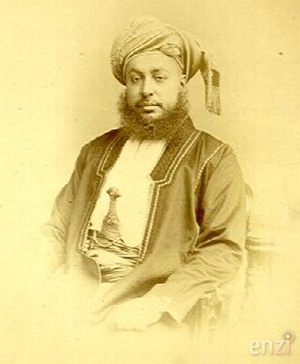Swahili & Arab peoples
Swahili
The Swahili is the name given to the coastal people who historically could be found as far North as Mogadishu (Somalia) and as far south as the Ruvuma River (Mozambique). They share a common language, widely spoken by
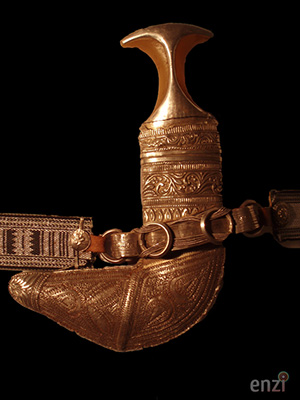
Swahili-Arab dagger which is secured by a belt.
non-Swahilis across East and Central Africa, called Kiswahili, and enjoy a city-based fusion of African and Arab culture.
As early as 2000 years ago, an a Greek navigation text (periplus) described the East African trading centre of Rhapta, on the delta along the Rufiji River, about 200km from Dar es Salaam. Rhapta is also described in the 3rd Century Chinese text, Zesan). Greeks and Romans called the area Azania. The Arabs talk about the Land of Zanj.
Written in AD 70, The Periplus of the Erythrean Sea describes the traders of the East African coast as ‘tall piratical people who owned their allegiance to the King of the Yemen. These people were probably the offspring of traders from Arabia who had settled along the Coast in pre-Islamic times, and they left almost no impact on the Coast. The East African Coast at this time was well-sailed and yielded considerably trade.
– The Periplus of the Erithraean Sea.
Even before the Yemeni-Arab traders, the Coast was inhabited by Bantu-speaking agriculturalists who lived in an area reaching roughly from Kenya’s Tana River in Kenya to the Webi Shebelle region of Somalia. These people were also fishermen and by 500 A.D. they were trading and migrating along the coast. Over the next three centuries migrant groups moved south, establishing settlements both on the coast and on adjacent islands. These independent polities were linked by trade as well as by a common culture and language, Swahili.
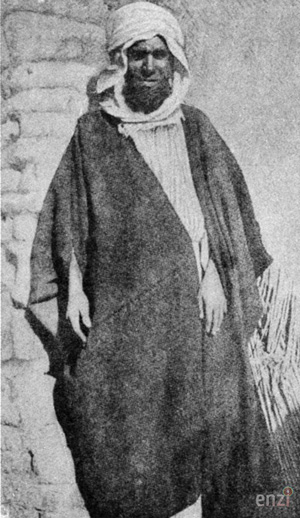
Persian man
In the 7th Century AD, there was an upsurge of Islam and a steady flow of people from the Arabian peninsula. These immigrants of the early Islamic period are said to have formed the 12 tribes. It is from this period that the Swahili people claim their origin. Religious, political and merchant migrants from the Arab peninsula, Persia, and India had started to settle among and intermarry with the Swahili towns’ African founders.
There is a very strong tradition that says that the first Muslims came from Shiraz in Persia – they were known as Shirazis. Today there is a somewhat abandoned community on the island of Wasini that claims origin to these immigrants. On islands such as Pate, and towns like Witu, there are individuals that are identify themselves as descendants from Chinese, Portuguese or German ancestors!
By the 12th century Swahili culture exhibited Arab and Asian cultural influences. A distinctive Swahili architecture had emerged, which reflected these influences. Houses made of coral rag and coral stone had replaced the circular mud-and-wattle buildings found in parts of inland East Africa. The ruins at the Gedi in Kenya provide one example of early Swahili architecture. Islam was also well established along the Swahili Coast by the 12th century, though elements of indigenous African religions remained.
During the Mazrui period, following a plea by the people of Mombasa to the Imam of Muscat to help drive out the Portuguese, there was another wave of migrations. Immigrations continued through the Al Busaid period in the early 19th Century.
The Swahili can be divided further into tribes though any attempts to do so have been confusing and frustrating at times. There are no clear cut boundaries as different Swahili communities around the East African coast welded, fueded, splintered, merged and with the passing centuries continuously absorbed influences from the Arabian peninsula. We venture some divisions of Mombasa Swahili tribes here:
There are other categorisations based on those Arabs who came to the Coast from the Portuguese (including but not limited to: Al-Busaid, Hanawiy, Jenbiy, Mandhry, Mazrui, Zehemiy) and later traders (including but not limited to, Al-Hajriy, Al-Jabir, the Jafery, the Sheher, Wal-Maula Dawila and theWa-Masheikh Ali Zubeidiy). There are also the Masharifu (including but not limited to, Al-Hussein, Ba-Alawi, Ba-Skut, Jamaat-ul-Laili, Shatry and Mahdally).
Today, there are several Kiswahili dialects spoken such as kiMvita, Kiamu (Lamu), KiBajun (Pate), Shirazi and Vumba (Wasini), Ozi and various “pidginised” versions upcountry such as Sheng which is spoken mostly around Nairobi.
Trade
The Swahili are reknowned dhow builders, sailors and navigators. There is little information about patterns of trade off the East Coast of Africa before the advent of Islam, however the Periplus mentions commodities such as ivory, rhino horn, tortoise shell and coconut oil. Ivory was a hugely sought after product. It was strong, easy to carve and both functional and decorative. Ivory could be regarded as the plastic of its day. After the death of Alexander the Great in 323 BC and the division of his empire into three, we know there was an increase in ivory imports from Africa. This was because trade with India, the other main source of ivory, became subject to higher tariffs.
The African coast of the Red Sea (in the North East) became staked out for delivery and consignment of elephant tusks. Gold from southern Africa was also much sought after in the Near East and in North Africa. Coins from Northern Africa and Persia, dating back to the 3rd century AD have been found in Zanzibar and Northern Tanzania, suggesting a strong tradition of trade between the Mediterranean world and the African world. Trade routes from East Africa went North as well as East. For example, the people of the Empire of Aksum (Ethiopia) traded with the people of the East Coast for gold. Among the expensive textiles imported, such as embroidered silks, blue cotton cloth was hugely prized. Blue dye was unknown in East Africa and the colour was regarded as having special powers. Blue cloth was unpicked and the prized strands were woven into white cloth.
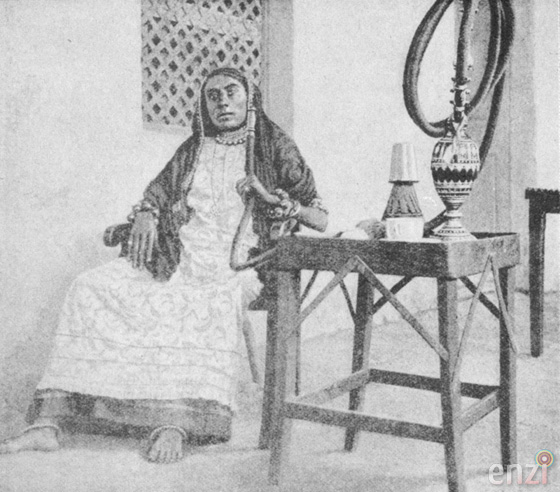
Swahili woman
There was also a vibrant trade in ceramics, mangrove poles, jewellery and spices.
The ruling class of coastal Swahili society – Sultans, government officials and wealthy merchants – used non-Muslim slaves as domestic servants and to work on farms and estates. The craftsmen, artisans and clerks tended to by Muslim and freed men. But the divisions between the different classes were often very flexible. The powerful slave and ivory trader Tippu Tip was the grandson of a slave. In the 19th century, the Sultans of the East Coast made themselves immensely rich through buying and selling slaves, playing off the French against the Portuguese. From 1834, the Portuguese were keen buyers of slaves after the Atlantic slave trade was closed down by the British.
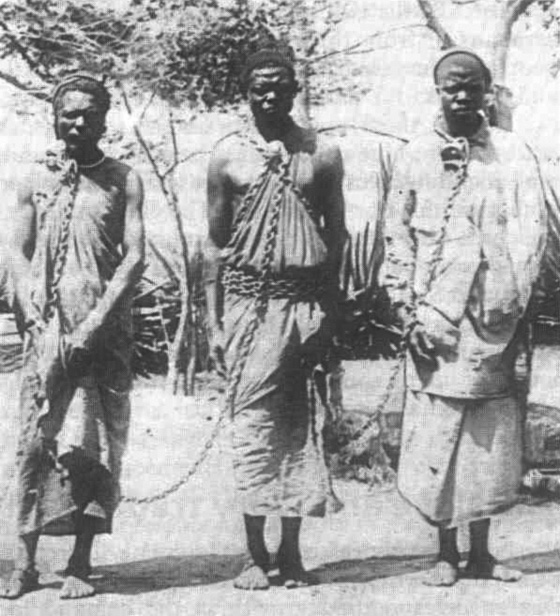
Slaves in chains.
Architecture
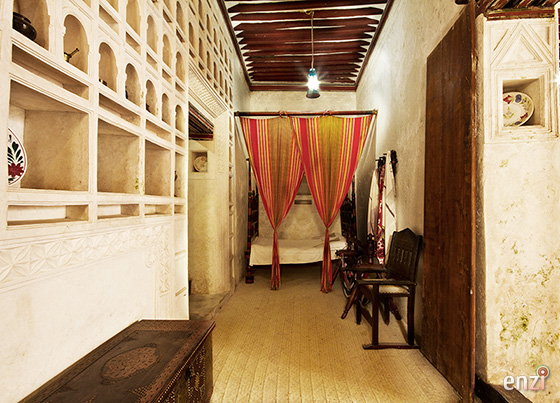
Interior of Swahili house in Lamu.
The Swahili had the finely honed technical and craft skills required to undertake finely constructed and furnished residential, commercial and religious buildings. The Swahili coast was dotted about with around 40 cities, small to large in size, starting in the North with Mogadishu (which is now in the capital of Somalia) and ranging south to Sofala (in modern Mozambique). Each city was well supplied with fruit and vegetables from the cultivated areas within and without the city boundaries. Swahili mosques and tombs before the 18th century had a style quite unique to the Swahili and independent of Arabia. Doors of houses were, and still are, ornately carved. There was a very large population of craftsmen, working in wood, stone and metal. The ruling classes (the Sultan, his family, and government officials) lived in large houses, some several stories high. Their plates were porcelain and came from China.
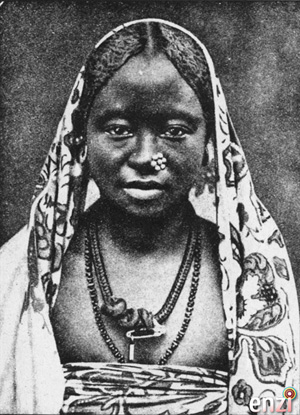
Swahili girl
Along the Kenyan, the ruins at Gede (near Malindi), Pate Island, the town of Lamu, Jumba la Mtwana, the old town in Mombasa and Wasini Island are all testament to the commercial, cultural and technical sophistication of the Swahili communities. When the Moroccan scholar and traveler Ibn Battuta visited the coast in 1331, he described in detail the splendour of the Sultan parading further north in Mogadishu.
One of the key traders with whom they did business was the Swahili traveler and trader Tippu Tip. He made himself a hugely rich and influential man in the region. A ruthless and commercially clever man, he specialised in long and dangerous treks into the interior to buy and capture slaves to sell at the coast, and had the monopoly of trade across an enormous territory stretching back from the coast. The Zanzibar slave market was only closed down in 1873.
Arts & Crafts
Throughout the centuries, the Swahili were reknowned gold and silversmiths, wood carvers, musicians, scribes and poets. Some of the crafts traditions live on although precariously as European and Asian tastes take hold with a new impatient, globalised population.
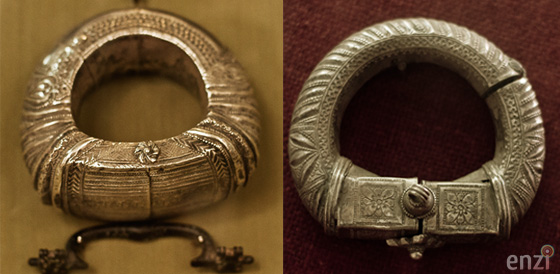
Finely crafted swahili bracelets from Lamu.

